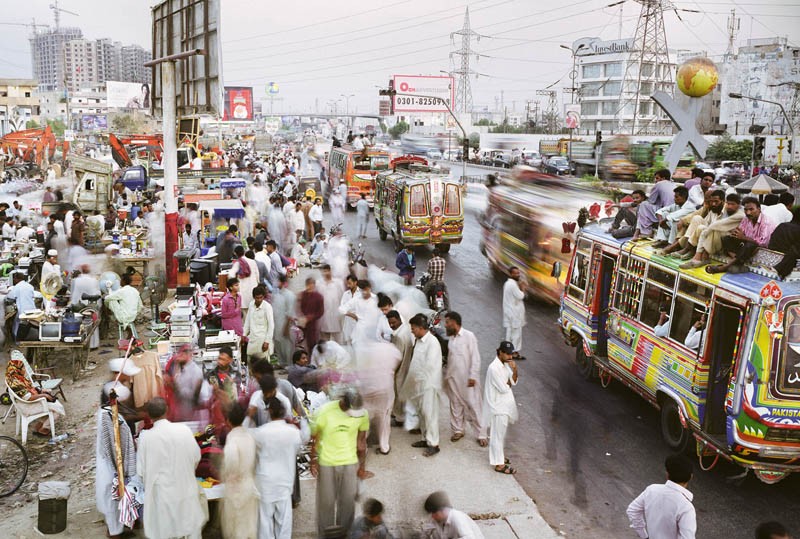
Karachi’s Bus Rapid Transit System may not be a viable option without fundamental changes in traffic planning

Samina (not her real name) alights from a Qingqi at Civic Centre to work as a domestic help in various flats in Gulshan-e-Iqbal. Nowadays she is made to spend Rs40 per day on commuting from her rented house in Golimar on up and down journeys consuming 90 minutes in total. Absence of decent public transport had a huge impact on the life of her entire family.
Many years ago, her family lived in Surjani Town in a modest three-room rented accommodation. Public buses would take her and her husband to respective work places while her three children could use the same mode of transport for going to school. Three years back, the buses began disappearing from operation. Erratic frequency of bus operations would make her spend about three hours on the road with an average spending of Rs120 per day due to multiple changes. Samina’s family ended up spending two third of their household income on commuting -- an unfeasible option indeed.
They left their reasonably spacious abode and rented a one-room shack in the same rent in Golimar. While commuting costs were rationalised, life for each family member became miserable due to overcrowded and dingy dwelling. When this scribe informed her that the city shall soon boast of an impressive ‘bus rapid transit (BRT) system’, she cynically raised many pertinent questions. Affordability of fares (for the ordinary), completion time of the project, single mode connectivity (to major places of work), safety for women (especially during early morning and late evening trips) and long term dependability were the main observations raised by her. If one reviews the recent transportation initiatives, very few of these questions could be answered.
Karachi has been fed with transportation projects possessing a fanfare value. Take the example of Lyari Expressway. Originally conceived as a private idea of few technocrats in 1992, the project was adopted for implementation by the Musharraf regime in 2001. It extended on a 16.5 kilometres long corridor along Lyari River. Sixteen bridges and four interchanges were the key ancillaries of the core design. It ended up dislocating and evicting about 24,500 houses (many of them properly leased), 3600 shops and commercial establishments, 250 educational and religious facilities and over 200,000 people.
It was initially estimated to cost Rs5.1 billion. The project is half complete with one of its corridors awaiting finishing point. Presently the estimated cost is Rs12.99 billion. Pronounced benefits of the project included connection of marginalised communities with work places and signal free movement of about 35000 vehicles.
It may be noted that many transport experts questioned the utility of this project as many of its objectives were met by the Karachi Northern Bypass (KNBP). Goods traffic, including heavy trailers and tankers, moved from port to Super Highway using KNBP and continue to do so till today. Completion of Lyari Expressway is reported to be stalled due to paucity of funds and alleged political opposition by the community whose houses and establishments were slated to be demolished in the second phase. No visible benefit to ordinary people is likely to be seen even if the expressway is completed.
Much trumpeted signal free corridors have helped increase velocity of moving cars and shifted congestion from one node to the other. 8000 buses were supposed to be brought on these and other roads to serve commuters about nine years ago. On the contrary, bus fleet in the city has been halved to a paltry 13,000, as reported by a senior police officer. There is a significant need for mini buses and coaches that help connect the dense low income neighbourhoods and winding residential locations along nullahs and waterways to many central and peri urban neighbourhoods in the city. The choice of a BRT at the cost of these fundamental improvements may not be a viable option and needs to be thoroughly re-examined.
The cost and management of the proposed BRT is also a vital issue that needs serious review. A document prepared by the Karachi Mass Transit Cell of the Karachi Metropolitan Corporation in 2012 informs that the total cost of KCR and seven corridors of BRT shall be Rs520.6 billion. An investment plan is also prepared to justify the initiation of this undertaking based on the possible enterprises that shall evolve from the BRT.
It is important to note that the institutional performance of local and provincial institutions is perhaps at record low during the recent times. The kind of professional handling and followup that may be required to manage a programme of this magnitude and scale may be very difficult to mobilise from the existing governmental framework. It is further feared that the BRT may cause enormous physical displacement along the existing corridors of movement during the period of implementation.
A capable traffic management, both through creation of alternate routes and policing, is urgently needed. People shall have to be sensitised about the possible benefits that they may derive from such an undertaking. Unless these questions are not appropriately addressed, the planned outputs may not be realised.
The people of Karachi need short, long and medium term solutions to their woes of commuting. The immediate increase in buses and mini buses, removal of impediments and encroachments from roads (for smooth flow of traffic) should be undertaken as a low cost driven short term action. Revival of Karachi Circular Railways, alignment of Qingqi routes to connect the KCR with neighbourhoods may be done as the medium term project while the planning and development of BRT may be commenced as the final leg of the work.